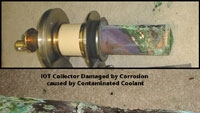IOT cooling contamination II

Contaminated cooling fluid is the starting place for problems that can lead to tube failure, but because it is an unseen problem, engineers are sometimes reluctant to accept the blame when that happens. Many times, the transmitter engineer will call the transmitter manufacturer when he has a tube problem instead of the tube manufacturer, because they have more direct contact with the former and little to no contact with the latter. But the tube manufacturers have a wealth of information and experience to offer the engineer who calls them and asks for help. (See Figures 1 and 2.)
As mentioned in the last tutorial, the two main glycol products used in today’s transmitters are Dowtherm SR-1 and Ucartherm, both from Dow Chemical. These coolants are heat transfer fluids that are formulated with 94-95 percent ethylene glycol and a specially designed package of industrial corrosion inhibitors. Ucartherm is dyed fluorescent yellow for leak detection purposes, while DowTherm is dyed fluorescent pink.
A new coolant on the market is WINTREX from Houghton Chemical. Although it is not yet being recommended for use in transmitter cooling systems, it is being tested by e2v for use with its tubes.
Starting out right
When a transmitter is installed, copper pipes and brass fittings are used to construct the cooling system, which means using solder with flux and Teflon tape, all of which must be flushed out of the system before the inductive output tube is installed. To do this, distilled water and powdered dishwashing soap can be used. The water is added to the system, the pumps are turned on and the mixture is circulated. Gas heaters are positioned beneath the heat exchanger to heat the water, and a tarp is usually thrown over the heat exchanger to aid in the heating. When the water gets above 120 degrees Fahrenheit (140 degrees is better), then two cups of powdered dishwashing soap is slowly added (to prevent clumps). Look for a soap that has low sudsing and can be disposed of down the drain safely. The wash cycle and the first two rinses can use tap water, if available, but the final rinse must be distilled water, which is used to keep the system clean even at this stage. Note that some utility water systems carry a great deal of sand, which will be deposited in your cooling system if used. (See Figure 3.)
Fill the system with 50 percent distilled water and 50 percent glycol. Be sure that the water and glycol come in factory-sealed containers, because there have been instances where dirty containers have been used to transport the liquids. The 50/50 mix of glycol and water is used wherever there is a chance of freezing. Other mixes are possible, but the glycol concentration should never fall below a 30 percent, because that is the minimum level required for the glycol and its additives to protect themselves and keep from breaking down prematurely.
These days, some installers use a citric acid flush to clean the cooling system, because some say that it does not require heating the liquid. A citric acid flush is used to clean automotive cooling systems, but even there the engine heats the fluid to operating temperature. So even if a citric acid flush is used, it is still recommended to heat the solution as above. When the transmitter is in operation, it will heat the coolant to anywhere from 90 degrees to 120 degrees, and if something is going to come loose at those temperatures, it could be bad news for your IOT. Always be sure that all cleaning agents are removed from the system — three clean flushes is just a minimum.
The professional video industry's #1 source for news, trends and product and tech information. Sign up below.
In cases of severe contamination to an existing transmitter, the above procedure should be carried out before the coolant is replaced.
When obtaining the water for the transmitter, make sure it is quality distilled water free of contaminates. Usually this means having between 250 to almost 700 gallons of distilled water on hand for a typical two-cabinet transmitter. The wide range reflects the possible use of tap water with the soap and for the first two clean-water flushes.
An incomplete initial cleaning and flushing of the cooling system will lead to major problems, when debris in the fluid collects on the channels of the IOT collector. This leads to cooling being reduced and a “hot spot” developing, which can easily lead to a collector melt down and tube failure. Also, if all the cleaning solution (dish soap) is not removed, it will cause the glycol to breakdown, so be sure the entire system is completely clean before adding the glycol-distilled water mix.
Once in operation
Once the transmitter has been running normally, the main factor to keep an eye on is how hot the coolant gets, because as the glycol’s temperature rises, the corrosion inhibitors start to break down. After a number of hot summers, the glycol can lose its ability to prevent corrosion and needs to be changed.
E2v used to recommend switching between a glycol mixture during the winter and pure distilled water during the summer, which would reduce the stress on the glycol when temperatures are at their highest. Although most engineers would not look forward to changing the transmitter’s coolant twice a year, it shows that the tubes can be cooled with just water.
The main reason for using glycol in the transmitter cooling system is to provide freeze protection in areas where this can occur. Pure water will cool the transmitter and actually does a better job at heat transfer than glycol. In fact, the flow rate of coolant must be increased when glycol is used to get the same transfer of heat.
But with today’s transmitters, this is not always possible because many installations use glycol-water column loads for reject and stations loads. These loads require glycol to present the proper impedance to the transmitter, so these systems would have difficulty running with just pure water.
It should be noted that there are several transmitter sites where pure water is used for the IOT and water column loads with no problems. The water column loads are mismatched somewhat, but as long as you are not making power calibrations with them (i.e. reject loads only), then it is possible to use pure water. One station in Canada used pure water with its water column station load but had it factory-tuned for proper VSWR at operating temperature, which worked out fine. If a transmitter uses a water-cooled resistor load for making power calibrations, then they too could run pure water in their IOTs as long as there was no chance of freezing.
Proper maintenance
Proper maintenance will keep a transmitter’s cooling system clean, and this, in turn, will lead to a longer life for your IOTs. The first thing that should be done is to have the coolant tested at least every year. The coolant manufacturers will usually test their own glycol, for a fee, and report whether it needs to be changed out. You can also use an outside lab to test your coolant; just be sure they are qualified to do this type of testing. Dow Chemical will do an analysts of your glycol, but their reports tend to be limited in scope, more of a pass/no pass, whereas an outside laboratory can give you a much more detailed report. In fact, a good way to compare the results would be to have an analysis done as soon as the transmitter is installed and use that report for comparison.
Some of these detailed analyses list levels of inhibitors, but without a reference, it’s hard to tell if it’s within limits. This is where consulting with the tube manufacturer comes in handy. (See Figures 4a and 4b.)
The main criteria for any glycol mix are the pH level, conductivity, oxidation and the level of corrosion inhibitors. The presence of glycolate is an indicator that the glycol is breaking down.
A simple test that any engineer can perform is a pH test using an inexpensive pH meter. After drawing a clean sample, you can read the pH of your coolant. It should be within the range of eight to 10.5. (See Figure 5.) Another check you can perform is to make sure the level in the reservoir tank is high enough that the returning coolant is below the level of the tank. If the returning coolant is above the tank level, then the coolant will be aerated, which contributes to the corrosion process.
Once you have determined that the coolant is getting close to the limits for pH and/or the levels of inhibitors, it’s time to change out the coolant. In the past, you could purchase additives to bring these levels back within range, but many believe that the cost of changing the coolant is far smaller than the risk of a damaged IOT. It is believed that the life span of glycol in a typical transmitter is about five years, but no manufacturer recommends that you wait that long. As long as the coolant is regularly tested, it will be apparent when it’s time to change it. (See Figures 6 and 7.)
At the minimum, the coolant should be drained and refilled, but it is always better to do one flush with distilled water and then refill the system if there were no indications of corrosion. But as mentioned above, if the analysis shows signs of corrosion, then a full cleaning should be performed before refilling the system.
Acknowledgments
Vijay Patel, Mark Strohecker and Neil O’Sullivan of e2v contributed to this tutorial.
Next time
The next “Transition to Digital” tutorial will cover multidepressed collector IOT cooling.
